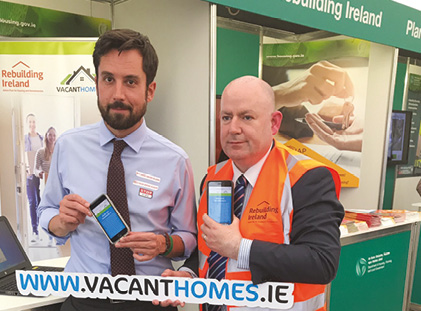Vacant Homes: a national initiative


Bringing vacant homes back into use has myriad benefits. eolas speaks with Mayo County Council Director of Services, Tom Gilligan about a mutually beneficial initiative to identify and utilise vacant dwellings suitable for habitation and, in so doing, swiftly increase housing supply to the benefit of local communities.
VacantHomes.ie is a website that was launched in August 2017 by Mayo County Council on behalf of the local government sector, as an online resource for anyone to anonymously log possible vacant properties and alert housing authorities who can then follow up with the owners to see whether the vacant dwelling is fit for use as a home.
The Minister for Housing, Planning and Local Government Eoghan Murphy TD announced the project as a component of the early initiatives already being undertaken by his Department and local authorities to progress the delivery of vacant homes back into use as soon as possible.
According to latest CSO figures there are more than 183,000 vacant homes across Ireland, although a number of local authorities and other commentators have since called into question the accuracy of this figure.
Tom Gilligan, Director of Services at Mayo County Council and the instigator of VacantHomes.ie provides a further insight into the importance of utilising existing vacant stock to increase supply.
“The Vacant Homes initiative is really born out of our commitment to the Rebuilding Ireland Action Plan for Housing and Homelessness. It’s a national website that delivers on behalf of the country. It’s a Government initiative to get existing vacant housing units back into use as quickly as possible.
“We recognised that utilising existing vacant housing stock was one of the best ways to increase supply and also this would help to provide homes for people who have a housing need. While it is recognised that vacant homes alone are not the sole answer to the current housing supply issue, their potential cannot be ignored. We all need to get involved in order to unlock this unused resource. A key housing priority of Project Ireland 2040, the National Planning Framework is the need to utilise existing housing stock as a means to meeting future demand. In Ireland today, where housing demand exceeds supply it is difficult to justify homes being left vacant, disused and neglected.”
Since its launch, the Vacant Homes initiative has received widespread support across Ireland and abroad. Thousands of people have made use of the resource with several thousand vacant properties logged to date. At present, the provinces of Leinster and Munster are the most responsive.
Gilligan outlines: “We’re very happy with the public response we’ve received thus far. We’ve had international contact and enquires, with Irish property owners based throughout the world interested in helping the current Irish housing crisis and therefore nominating their vacant Irish homes as part of the solution.
“The Vacant Homes initiative has been well received by people both domestically and abroad and I really would like to acknowledge and thank everyone who has listed property details already. It’s an ongoing initiative and a resource for local authorities aiding them in getting unoccupied properties back into use.”
So far, a number of local authorities have highlighted the work of VacantHomes.ie. Louth County Council has credited it with identifying over 30 homes in its administrative area which have been deemed suitable for social housing, with a number of these homes already in the Council’s ownership or in the process of being taken into the council’s ownership for social housing use. Other Councils have indicated similar experiences arising from the website.
Tom Gilligan is calling on local people and vacant property owners to come forward and utilise the Vacant Homes initiative’s services.
“We know that every vacant home has a story to tell and we want to hear that story. Local people have the local knowledge. They’re able to help us identify these properties but they’re also able to help us understand why these properties are vacant,” says Gilligan.
“A particular thing about it is that we are also getting a lot of property owners coming to us telling us that they are aware of the Vacant Homes initiative. They would like to see their properties that have been vacant for a period of time put back into use, in order to help provide a home for those in need.
“That’s the kind of response we are getting. Everyone can get involved and we want everyone to take ownership, to help us work our way through it, to solve the current shortage of housing supply we have in this country,” he explains.
There are a number of schemes in place that vacant home property owners can avail of under Rebuilding Ireland, the Action Plan for Housing and Homelessness. Two schemes, the Repair and Leasing and Buy and Renew complement one another. Local authorities can approach owners of vacant, privately-owned houses in need of repair, with the option to either lease/repair the housing unit, or to buy and renew the unit. The total amount available in 2018 for the Repair and Leasing and Buy and Renew Schemes is ⇔60 million.
On further benefits to property owners, Gilligan says: “From our point of view, aside from benefiting the existing housing need, there’s a number of substantial positives of bringing vacant homes back into use. Obviously for the owner, you have the aspect in relation to rental income and the condition of the buildings that they don’t deteriorate further.”
The Vacant Homes initiative does not only benefit property owners. Communities, local services and our local economies will strengthen and be more sustainable as a result of bringing vacant homes back into use.
“We know that every vacant home has a story to tell and we want to hear that story. Local people have the local knowledge. They’re able to help us identify these properties but they’re also able to help us understand why these properties are vacant.”
“For communities you have that sense of place, vacant properties can become an eyesore in the local community. Not only will the value of the property reduce over time but the presence of a vacant or derelict property in an area can potentially devalue neighbouring properties and reduce the likelihood of property sales and investment.
“There are so many benefits of bringing vacant homes back into use. It’s not only for the housing need but it benefits the owner, it benefits communities and it benefits the local economy. Particularly as regards to our large urban areas, our towns and villages, they might be suffering from decline. This is a way to bring some activity and increased vibrancy back into those areas.”
On utilising vacant homes, Gilligan concludes: “As a nation I think it is important we pursue this in order to capture the many benefits, both from an economic point of view and particularly from a community point of view. There are many vacant properties in towns and villages throughout the country and everyone would prefer to see them returned to purpose.
“It’s not always possible because there could be very legitimate reasons why a property is vacant. Someone might be in a nursing home or someone might be in the care of a relative. The other reasons we find as well is that where someone has died and the home is in probate and there’s a dispute in certain situations as to who actually owns it.
“Vacanthomes.ie also provides advice for property-owners to encourage and support them in returning their property to purpose. In an ideal scenario our efforts will aid the restoration of vacant units to their former glory.”
VacantHomes.ie is collaborating with Code For Ireland to develop an app for vacant homes.
For more information:
T: @VacanthomesIRL
E: info@vacanthomes.ie
W: www.vacanthomes.ie/







